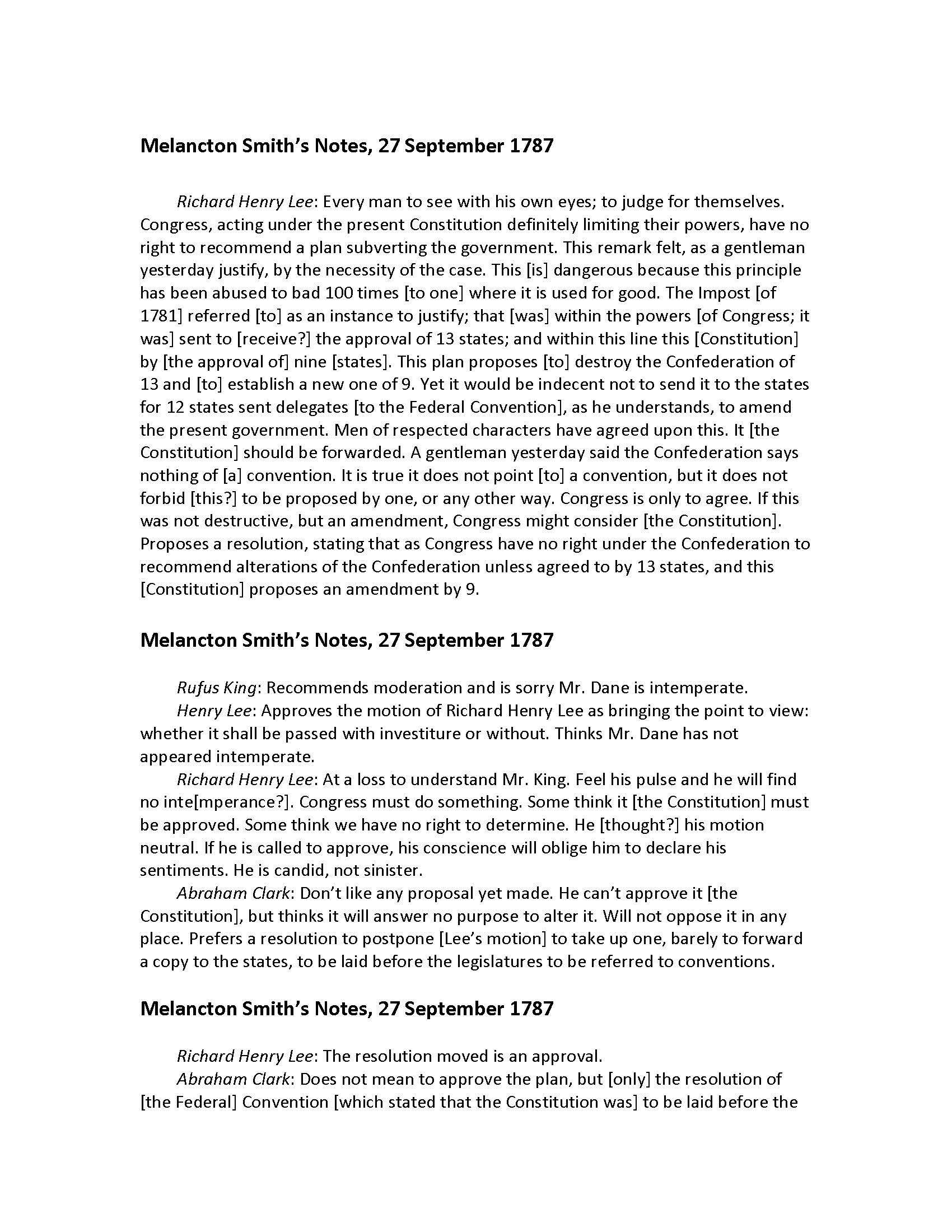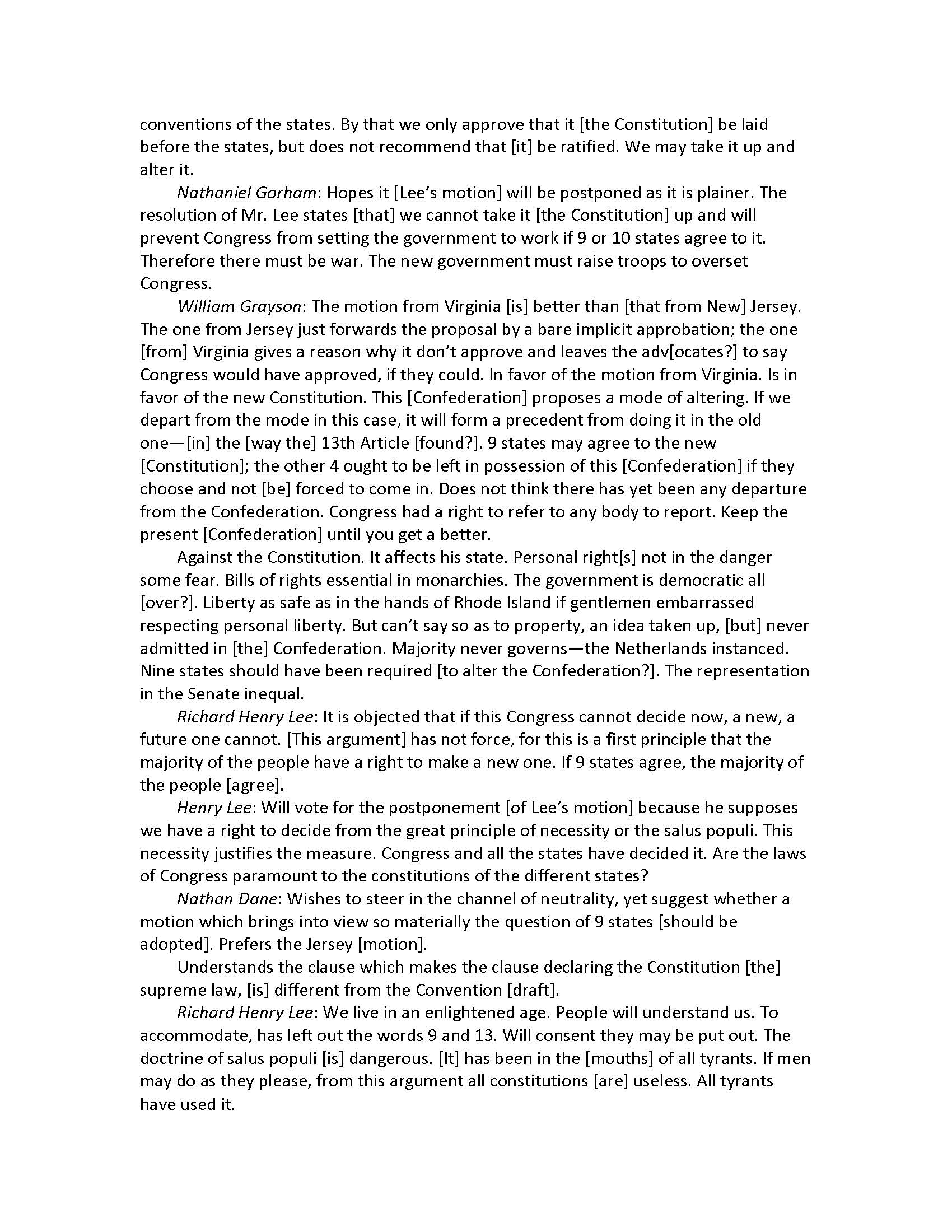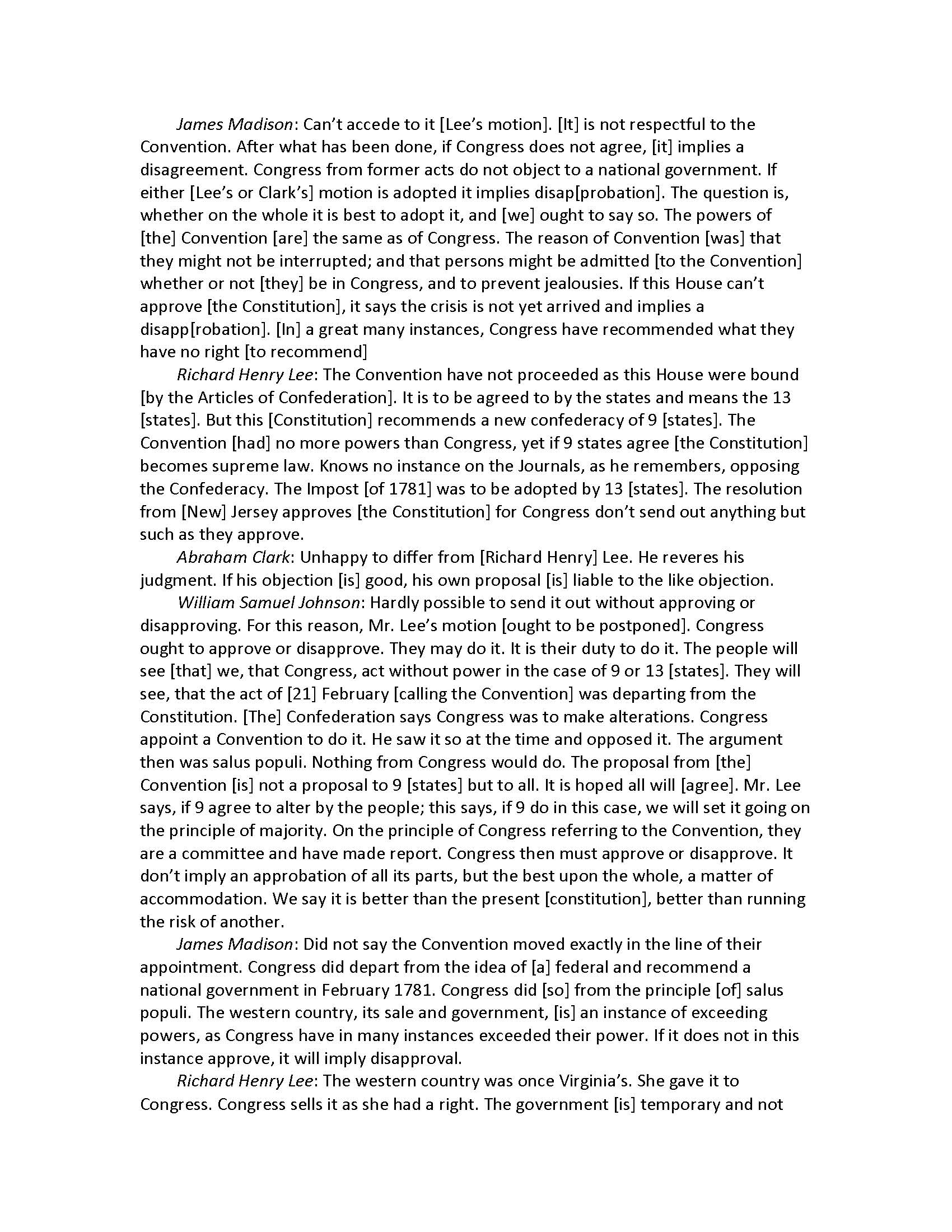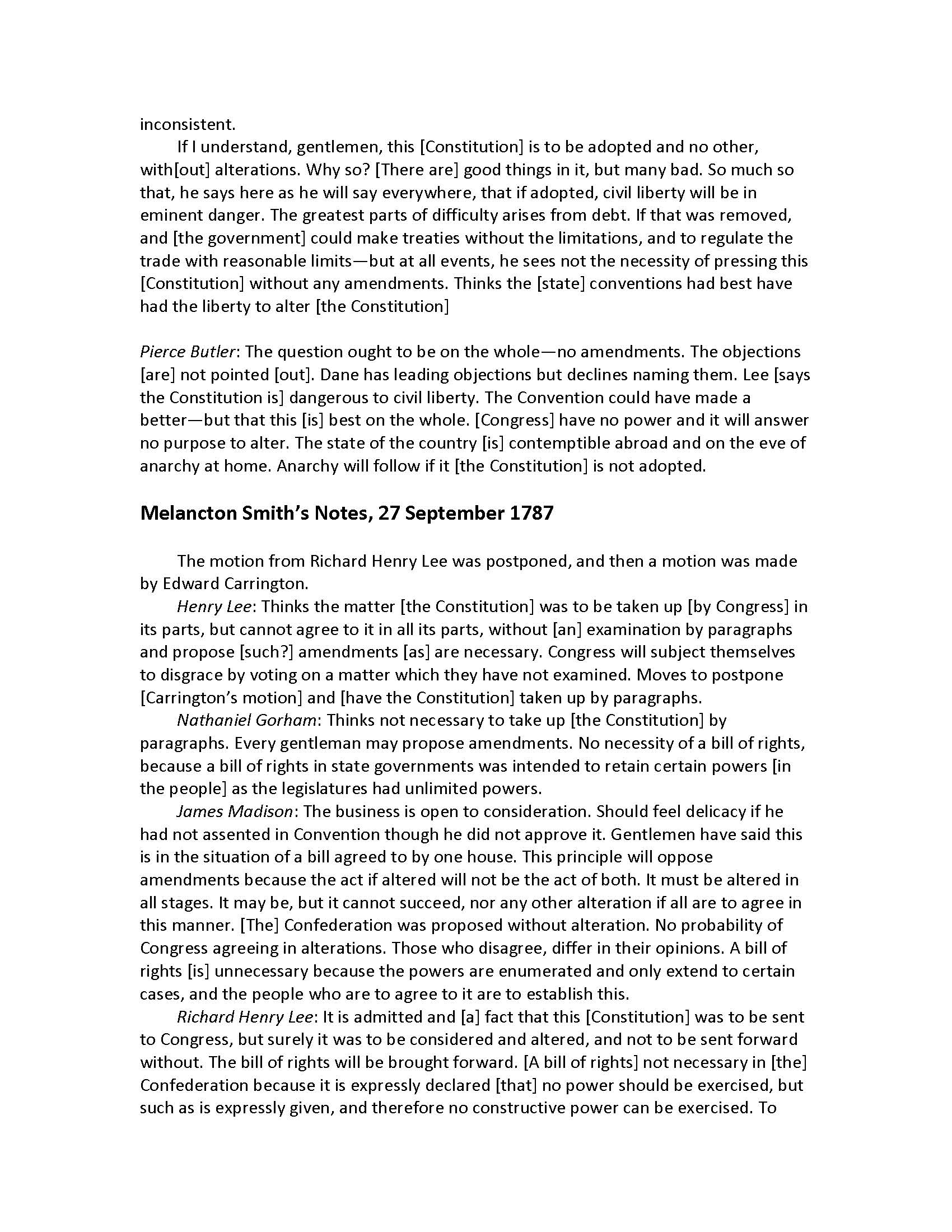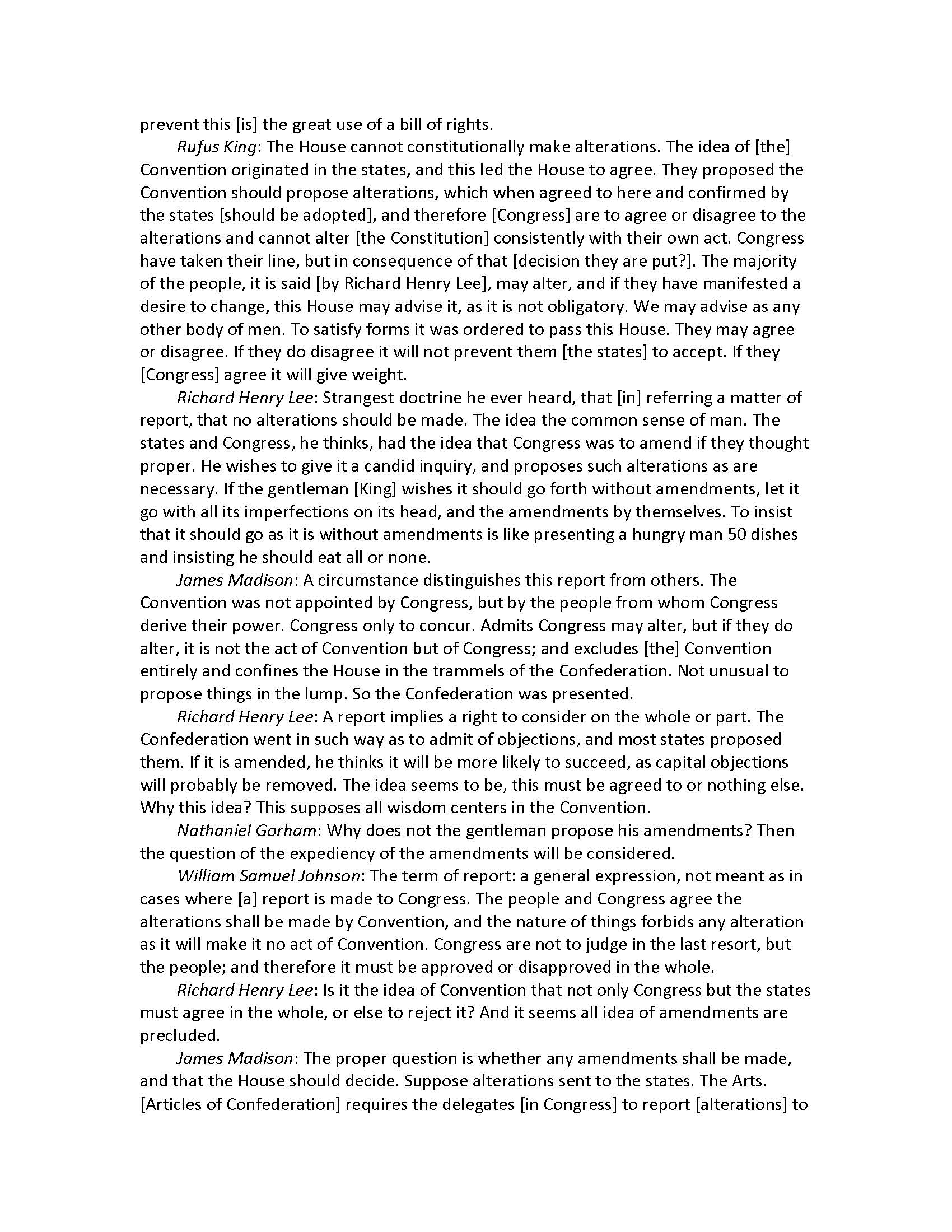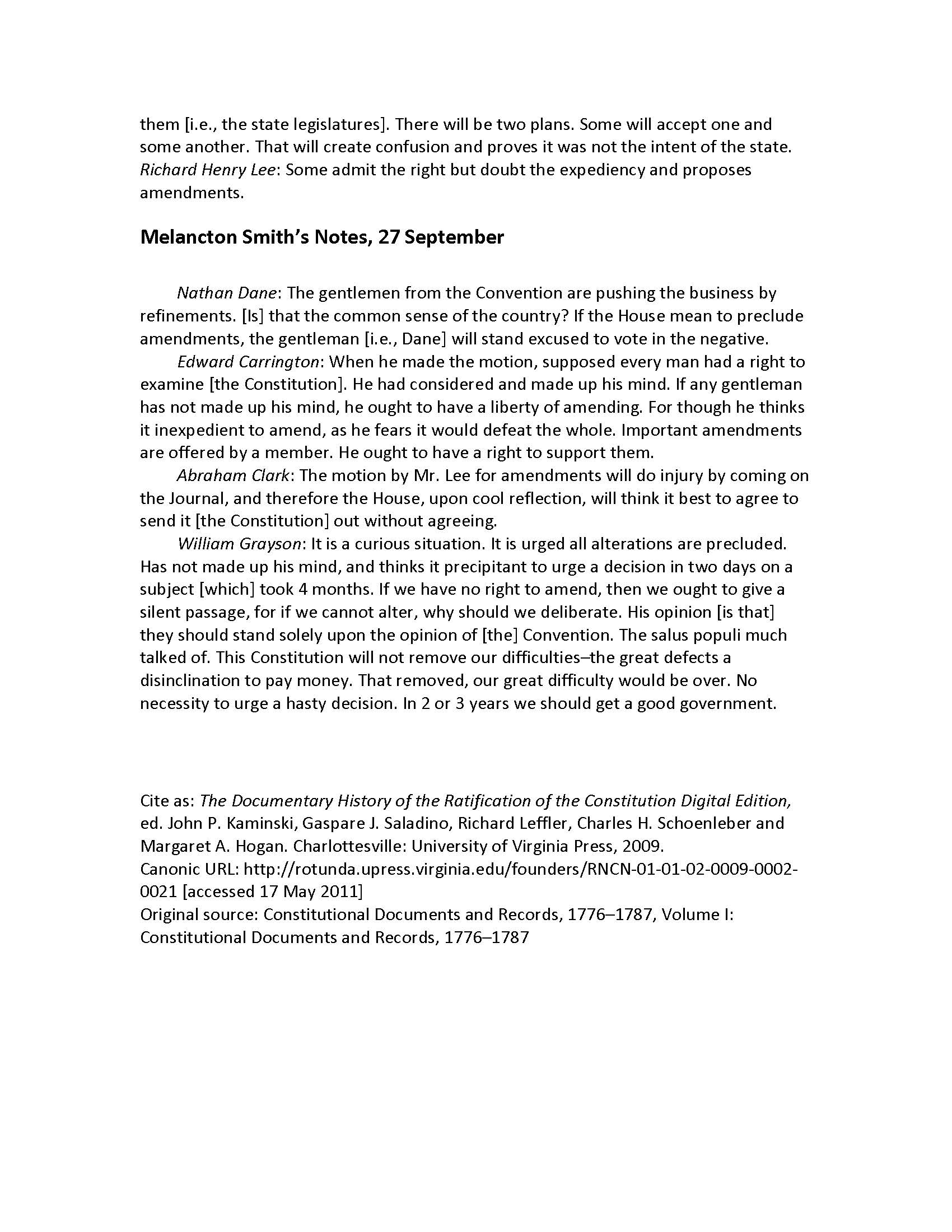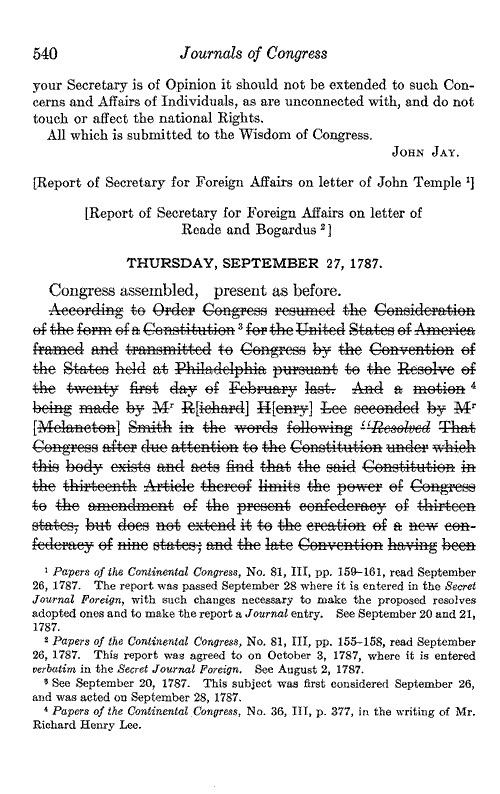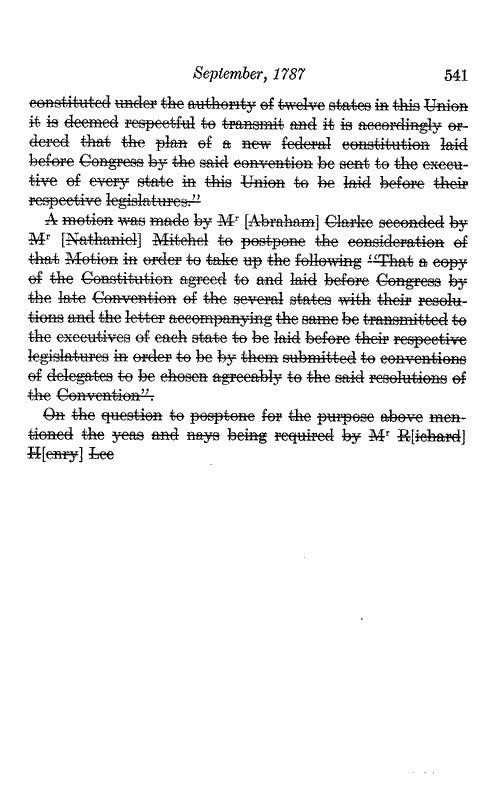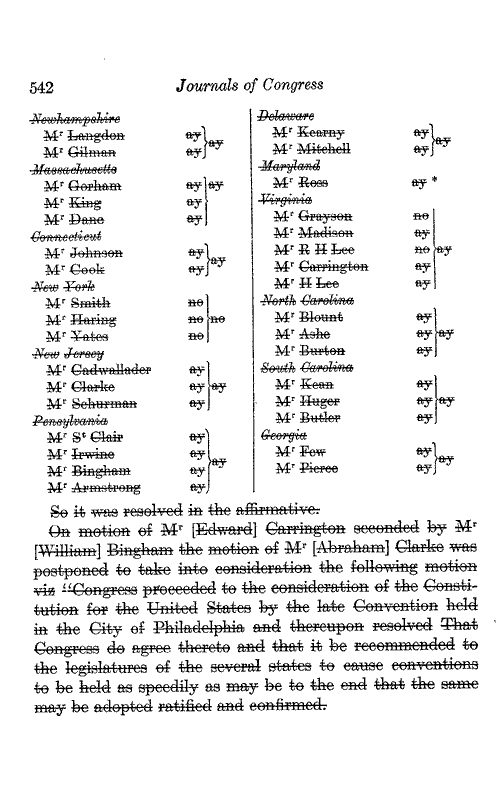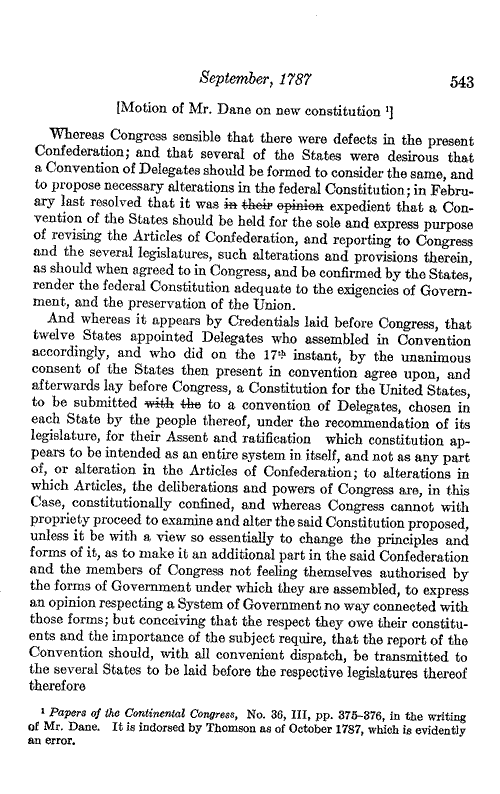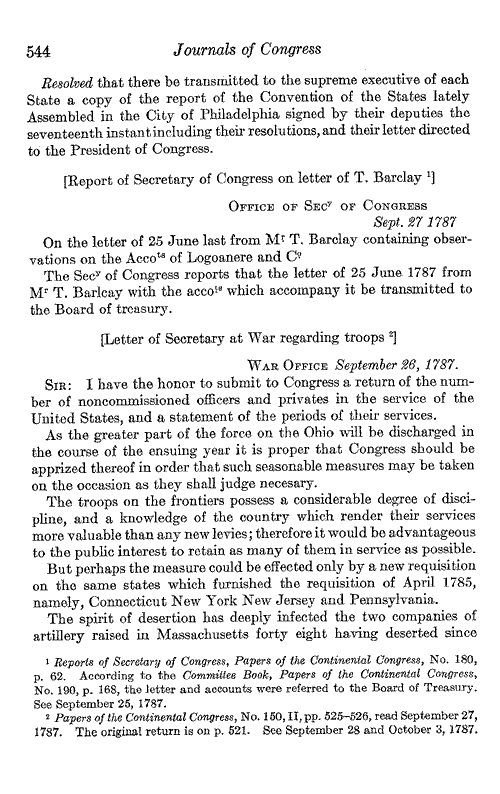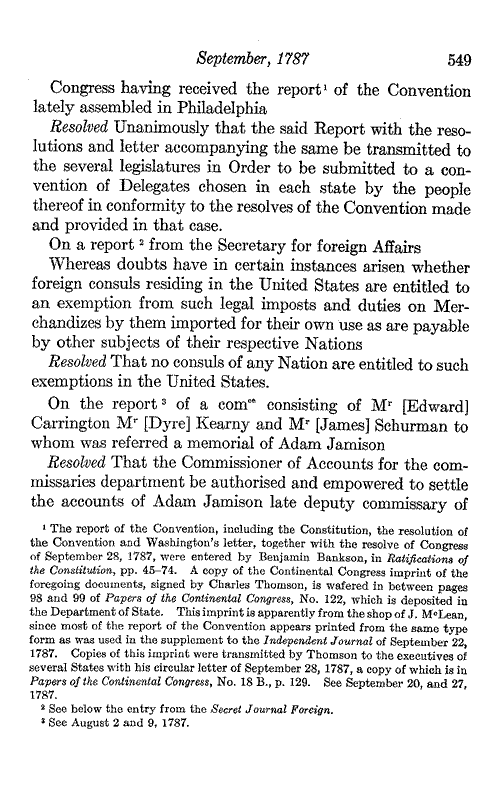
Subjects Inside: Article
V Applications
FAQ,
Application Counts By
Congress, Articles,
AVC Legislative Report, CRS Reports,
Convention of State, Compact for America, COS, CFA--Which States are Which?, The Historic Record of COS, COS, CFA Laws, COS Articles, CRS Reports on COS/CFA, COS, CFA Financial Records, CFA Financials, COS Financials, COS/CFA Financial Conclusions, John
Birch Society, Con-Con, Runaway
Convention, Who Called the Convention, Congressional
Vote on a "Runaway" Convention, "Obey
the Constitution, Only Two More States", Illegal Rescissions, The Phony Burger Letter, The
Madison Letter, Fotheringham Exchange, JBS Articles, Sibley
Lawsuit, General Interest, Article V.org,
Robert Natelson, History
of Article V, Counting the Applications, The Numeric Count History, Congressional Decision of May 5, 1789,
Development of Article V, The Committee of the Whole, The Committee of Detail, August 30, September 10, Committee of Style, September 15, Official Government Documents,
History of FOAVC, Founders,
Audio/Visual,
Links,
Contact
Us, Legal
Page, 14th Amendment, The Electoral Process, Packets,
Definitions,
Numeric, (
Applications grouped by numeric count as required by the Constitution),
Same Subject (Applications grouped by amendment subject, not required by the Constitution for a convention call).
Page 6 B--Who Called the Convention, Congressional Vote on A "Runaway" Convention
Who Called the Federal Convention of 1787?
The Federal Convention
of 1787 met in Philadelphia
from May 25, 1787 to September 17, 1787 during which time it wrote the
proposed Constitution. As discussed
elsewhere on this site the proposal Constitution (including Article
V) underwent numerous revisions and drafts. On
Monday, September 17, 1787, the Federal Convention of 1787 concluded
its work and sent the engrossed proposed Constitution to Congress which
was meeting
in New York.
The proposed constitution was published in the Journals of
the Continental
Congress on Thursday, September 20, 1787. Formal debate on whether to
agree the
recommendation of the Federal Convention of 1787 began on September 27,
1787. Copies of all records found in the Journal of Congress
can be examined on our website.
In the discussion below copies of records either from the Journal of
Congress or pages from "The Records of the Federal Convention of 1787"
by Max Farrand are presented. For reading purposes the images may be
enlarged by clicking on the appropriate page image.
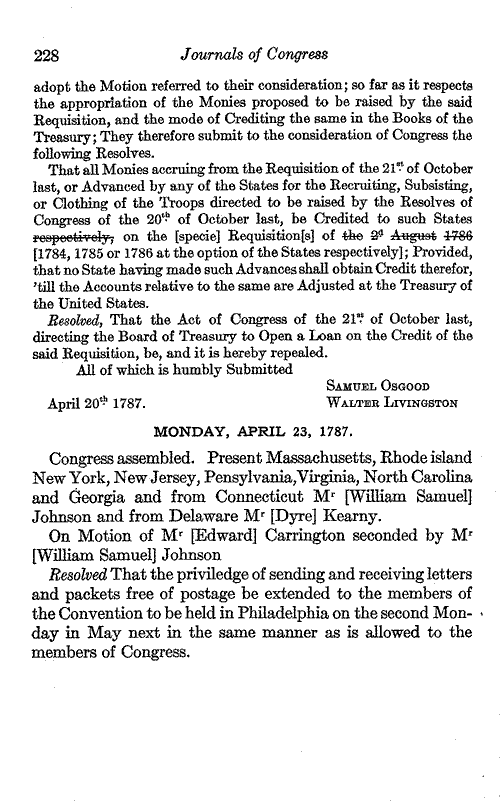 Robert Natelson, (See: Page 10), has stated the
state of Virginia "called" the Federal Convention
of
1787 rather than Congress. Natelson further
asserts
Congress accepted expansion of convention authority by passage of an
April 23,
1787
resolution granting franking privileges to the convention. He asserts
this action proves
Congress accepted expansion in authority for the Federal
Convention of 1787 beyond "merely proposing amendments to the Articles
of Confederation." (Natelson provides an erroneous link to a page of
the Journal
of Congress in his article discussing the resolution. The correct page
is shown at left, click to enlarge).
Nothing in the April 23, 1787 resolution supports Natelson's assertion
as
fact. There is no discussion by Congress that day indicating what
convention
power is expanded with franking privileges nor an explanation of how
granting franking privilege
expands convention power. Based on the published public record FOAVC
instead
believes the
franking resolution was no more than a budgetary procedure by Congress.
Public record shows neither
Congress or any state advanced any operational funds to the
convention prior to its convening in May, 1787.
Robert Natelson, (See: Page 10), has stated the
state of Virginia "called" the Federal Convention
of
1787 rather than Congress. Natelson further
asserts
Congress accepted expansion of convention authority by passage of an
April 23,
1787
resolution granting franking privileges to the convention. He asserts
this action proves
Congress accepted expansion in authority for the Federal
Convention of 1787 beyond "merely proposing amendments to the Articles
of Confederation." (Natelson provides an erroneous link to a page of
the Journal
of Congress in his article discussing the resolution. The correct page
is shown at left, click to enlarge).
Nothing in the April 23, 1787 resolution supports Natelson's assertion
as
fact. There is no discussion by Congress that day indicating what
convention
power is expanded with franking privileges nor an explanation of how
granting franking privilege
expands convention power. Based on the published public record FOAVC
instead
believes the
franking resolution was no more than a budgetary procedure by Congress.
Public record shows neither
Congress or any state advanced any operational funds to the
convention prior to its convening in May, 1787.
There is no record of
any funds received during the convention for its operational expenses.
Instead the convention
kept a tally of its expenses and forwarded these for reimbursement at
the
conclusion of the convention. This meant delegates and convention alike
were dependent on their own resources and the good graces of local
business given the dubious credit of the national government (one of
the reasons for holding the convention). Granting franking privileges
was merely a means to keep costs down.
As discussed elsewhere on this site
there
is a difference between the words "alter" and "amend." Moreover
Congress had already expanded the powers of the Federal Convention of
1787 beyond the limited word "amend" using the broader word
"revise" to describe the task assigned the convention. Having done so,
it had
no reason to revisit the issue when discussing franking privilege. Natelson
makes the same mistake in
wordage as JBS/Eagle Forum; there was no power to "amend" the Articles
of Confederation.
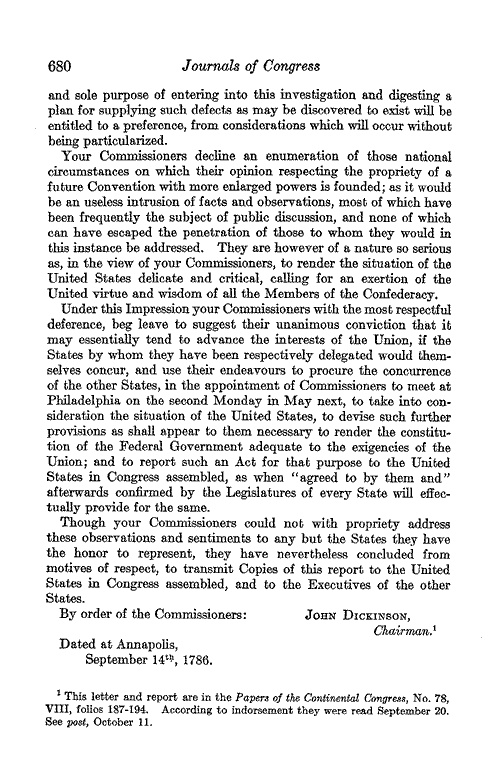 Further historic record proves Natelson wrong on who "called" the
convention. If, as Natelson
presumes, Congress did not call
the
Federal Convention of 1787, then the Annapolis
Convention of 1786 did so by setting a time and place for the
convention. According to historic records,
that convention of 12 men representing five states met in a tavern in
Annapolis, Maryland at the suggestion of James
Madison. The announced purpose of the convention was to discuss issues
of interstate trade. The convention determined it lacked sufficient
membership to make any recommendations but did request Congress call a
general convention for the following year (See image right, click to enlarge).
Further historic record proves Natelson wrong on who "called" the
convention. If, as Natelson
presumes, Congress did not call
the
Federal Convention of 1787, then the Annapolis
Convention of 1786 did so by setting a time and place for the
convention. According to historic records,
that convention of 12 men representing five states met in a tavern in
Annapolis, Maryland at the suggestion of James
Madison. The announced purpose of the convention was to discuss issues
of interstate trade. The convention determined it lacked sufficient
membership to make any recommendations but did request Congress call a
general convention for the following year (See image right, click to enlarge).
As the convention in
its 1786 report to Congress (See Page 12 Table 2) clearly understood it lacked authority
to call a national
convention Natelson in 2016 correctly states the Annapolis Convention
did not have
authority to
call a national convention. Instead Natelson insists the
state of Virginia had authority to call a national convention.
Apparently, according to Natelson, than for no other reason
than in response to the "call" by the Annapolis its legislature was the
first to echo the "call" by passage of a resolution. Natelson
provides no legal citation from the Articles of Confederation or
Virginia state law of that time granting the state of Virginia
authority to call a
national
convention.
However, as recognized by the Annapolis Convention, the
Articles of Confederation did give Congress
authority to call a convention. Article XIII states, "Every State shall
abide by the determination of the United States in Congress
assembled, on all questions which by this confederation are
submitted to them." The question of calling a convention for the
express purpose of "revising" the Articles of Confederation was put
before Congress by the report of the Annapolis Convention
commissioners. Under the terms of the Articles of Confederation the
decision of Congress to call the Federal Convention of 1787 was
authorized
under the national law of that time and was expressly removed from all
states. Therefore plainly the state of Virginia did not have authority
to decide the "question" of a
convention call. Congress clearly did. Congress used this authority to
issue the actual convention call on February 21, 1787 and thus was the
body that "called" the Federal Convention of 1787.
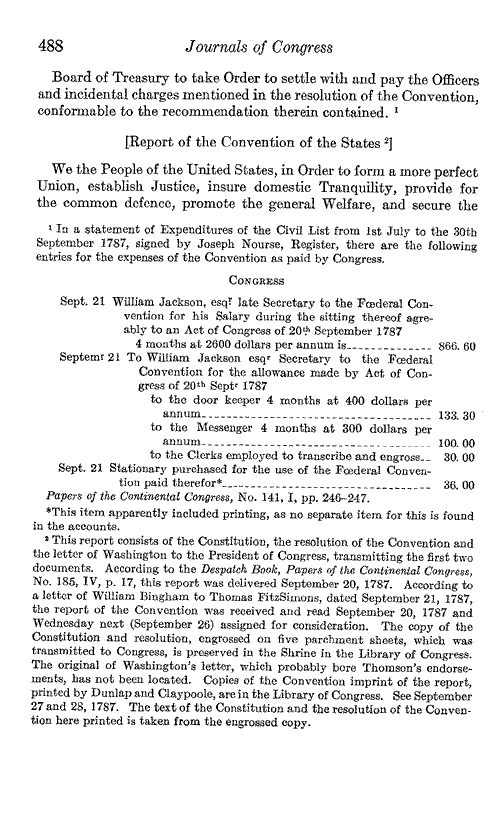 Any
lingering doubt as to who had
authority to call the convention is resolved by answer to the two most
pragmatic questions about the convention--who funded the Federal
Convention of 1787 and to whom did the convention report? Obviously,
if, as Natelson contends, the state of
Virgina, (or some other state), actually called the convention then
reasonably those responsible for the convention call would bear
the cost of holding it. This was not the case. Together with the
proposed
Constitution and other paperwork the Federal Convention of 1787
submitted a
bill to Congress for $1163.90 for convention expenses consisting of
wages,
supplies and printing. In today's dollars, the cost of the
Federal Convention of 1787 was approximately $30,000 of which its
secretary William Jackson was paid approximately $22,000 for
four months work.
Any
lingering doubt as to who had
authority to call the convention is resolved by answer to the two most
pragmatic questions about the convention--who funded the Federal
Convention of 1787 and to whom did the convention report? Obviously,
if, as Natelson contends, the state of
Virgina, (or some other state), actually called the convention then
reasonably those responsible for the convention call would bear
the cost of holding it. This was not the case. Together with the
proposed
Constitution and other paperwork the Federal Convention of 1787
submitted a
bill to Congress for $1163.90 for convention expenses consisting of
wages,
supplies and printing. In today's dollars, the cost of the
Federal Convention of 1787 was approximately $30,000 of which its
secretary William Jackson was paid approximately $22,000 for
four months work.
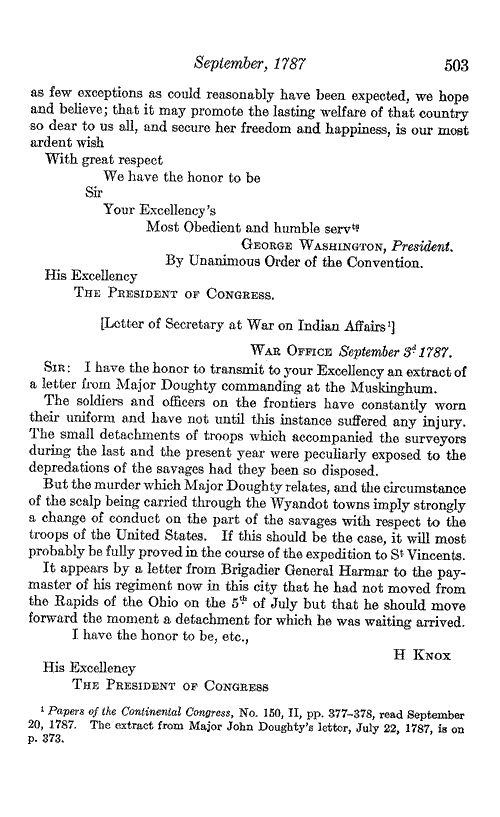
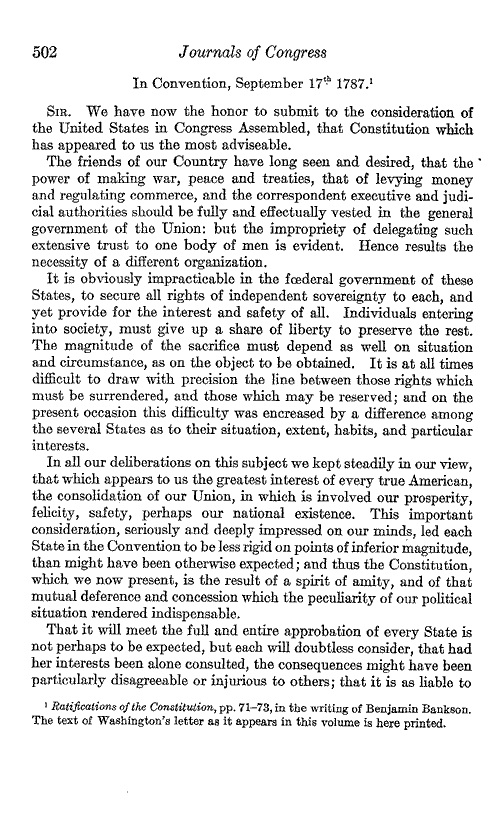 Further the
convention correspondence sent directly to Congress contained a
specific letter of request by convention
president, George
Washington, that
Congress consider
the proposal of the convention. Had the convention
believed it had authority of amendment as JBS/Eagle Forum contend
instead of a recommendation that Congress consider its proposal, the Federal Convention of 1787 would have informed Congress of its decision. Had a state,
such as Virginia, been responsible for the call, obviously all
correspondence from the convention would have been directed to that state and that state would have either been
"informed" or requested to "consider" the recommendation of the
convention.
The "consideration" of something includes the
possibility of rejection or
modification. The use of the word by the convention means its delegates
realized Congress
could reject their proposal, modify it or transmit it as written to the
states. Thus, whatever Congress, not
the Federal Convention of 1787 decided, would be the proposal
considered by the states as the "question" of what to propose to
resolve the "exigencies of Government and preservation of the Union." Thus, according to public record and acknowledged by the
Federal Convention of 1787, Congress, not the
convention, decided whether to propose the new Constitution,
determined the final version of that proposal (unaltered from that
proposed by the convention) and established under what
terms that proposal would be considered by the states. This is a far
cry
from the utterly wrong version of history set forth
by JBS/Eagle
Forum as its basis to oppose an Article V Convention.
Further the
convention correspondence sent directly to Congress contained a
specific letter of request by convention
president, George
Washington, that
Congress consider
the proposal of the convention. Had the convention
believed it had authority of amendment as JBS/Eagle Forum contend
instead of a recommendation that Congress consider its proposal, the Federal Convention of 1787 would have informed Congress of its decision. Had a state,
such as Virginia, been responsible for the call, obviously all
correspondence from the convention would have been directed to that state and that state would have either been
"informed" or requested to "consider" the recommendation of the
convention.
The "consideration" of something includes the
possibility of rejection or
modification. The use of the word by the convention means its delegates
realized Congress
could reject their proposal, modify it or transmit it as written to the
states. Thus, whatever Congress, not
the Federal Convention of 1787 decided, would be the proposal
considered by the states as the "question" of what to propose to
resolve the "exigencies of Government and preservation of the Union." Thus, according to public record and acknowledged by the
Federal Convention of 1787, Congress, not the
convention, decided whether to propose the new Constitution,
determined the final version of that proposal (unaltered from that
proposed by the convention) and established under what
terms that proposal would be considered by the states. This is a far
cry
from the utterly wrong version of history set forth
by JBS/Eagle
Forum as its basis to oppose an Article V Convention.
The Debate In Congress; The Vote on a "Runaway" Convention
Debate in Congress over the proposed Constitution began on Thursday,
September 27, 1787 ten days after the convention had adjourned. The
proposed Constitution and all other associated documentation from the
Federal Convention of 1787 was published in full in
the Journal of Congress on
September 20, 1787. The week gave members of Congress ample time to
study the proposal and to take positions regarding it. The
Journal of Congress did not, as is the custom today, recount all words
spoken in Congress verbatim.
Fortunately Melancton Smith, a member of
the New York delegation, took detailed notes of the comments made
during
the debate (reprinted below; click to enlarge). The
debate centered on two points with opposition to the proposal lead by
Richard Henry Lee of Virginia. First, whether Congress
would exceed its
authority in proposing the new Constitution (and thus agree the
convention that proposed it was a "runaway" as alleged by JBS/Eagle
Forum). Second, whether Congress had
authority to alter the proposed Constitution before submitting it to
the states.
The Melancton Notes
Lee,
Clarke, Carrington, Dane and Final Resolution By Congress
In all, four
resolutions were debated in Congress on September 27, 1787. Ultimately
none were accepted by Congress.
The first resolution by Richard Henry Lee of Virginia, (seconded by
Melancton Smith of New York) read: "Resolved
That Congress after due attention to the Constitution under which this
body exists and acts find that the said Constitution in the thirteenth
Article thereof limits the power of Congress to the amendment of the
present confederacy of thirteen states, but does not extend it to the
creation of a new confederacy of nine states; and the late Convention
having been constituted under the authority of twelve states in this
Union it is deemed respectful to transmit and it is accordingly ordered
that the plan of a new federal constitution laid before Congress by the
said convention be sent to the executive of every state in this union
to be laid before their respective legislatures."
By a vote of 26-5 Congress rejected
Lee's "runaway" convention
resolution. Logically, if Congress did not have power to "extend...to
the creation of new confederacy" any convention it called did not have
authority to propose it. Therefore any such convention would have
exceeded its "scope" and therefore was a "runaway" convention. As
Congress voted down Lee's resolution it also resolved the question of
whether the Federal Convention of 1787 was a "runaway" and officially determined the
convention was not
a "runaway" convention. Congress had authority to decide this question
under the authority granted it by the Articles of Confederation.
Having officially disposed of the "runaway" convention theory of Lee's
(and therefore JBS/Eagle Forum),
Congress considered three other proposals each favoring submission
of the proposed Constitution to the states but under different
circumstances. Each in turn was "postponed" in favor of the next
proposal. In the end no proposal was affirmed by Congress on September
27, 1787.
The second resolution of September 27, 1787 by Abraham Clarke of New
Jersey (seconded by
Nathaniel Mitchell of Delaware) reads: "That a copy of the Constitution
agreed to and laid before Congress by the late Convention of the
several states with their resolutions and the letter accompanying the
same be transmitted to the executives of each state to be laid before
their respective legislatures in order to be by them submitted to
conventions of delegates to be chosen agreeably to the said resolutions
of the Convention."
The third resolution by Edward Carrington of of Virginia (seconded by
William Bingham of Pennsylvania) read, "Congress proceeded to the
consideration of the Constitution for the United States by the late
Convention held in the City of Philadelphia and thereupon resolved That
Congress do agree thereto and that it be recommended to the
legislatures of the several states to cause conventions to be held as
speedily as may be to the end that the same may be adopted ratified and
confirmed."
A fourth resolution was made by Nathan Dane of Massachusetts with no
record of a second in Journal of Congress and is shown in the
fourth and fifth panels above. As there was no recorded second it is
unclear whether
this resolution was actually considered by Congress as it appears not
to
have been properly introduced on the floor. In any event it was not
transmitted to the states.
On September 28, 1787 Congress unanimously passed a fifth resolution: "Resolved Unanimously
that the said Report with the resolutions and letter accompanying
the same be transmitted to the several legislatures in Order to be
submitted to a convention of Delegates chosen in each state by the
people thereof in conformity to the resolves of the Convention made and
provided in that case."
There is no record of what events occurred
among
members of Congress after the four resolutions of September 27, 1787
were introduced and voted on and defeated. There is no
record who wrote the final resolution, who seconded it or why it was
"unanimously" approved apparently
without debate by Congress though it appears to be based on the Clarke
resolution. However the final vote was arrived at, the
language is conclusive. Congress
officially (and unanimously) agreed in all aspects with the
recommendations of the
Federal Convention of 1787 and forwarded those recommendations to the
states for their consideration. Unlike the previous four motions, all
of which failed, the final language clearly
shows agreement on the part of Congress with the proposed Constitution
and its method of ratification thus satisfying the term "agreed"
expressed in the Articles of Confederation.
This vote is conclusive as to the question of
whether
the Federal Convention of 1787 was a "runaway" convention as
characterized by JBS/Eagle Forum. If
Congress believed the convention exceeded the authority granted it
in the
February 21, 1787 call, Congress ultimately would have accepted Lee's
resolution. There was a recorded vote which clearly shows Congress
rejected the notion the Federal Convention of 1787 was a "runaway"
convention. Thus, by official vote of Congress, as empowered by the
Articles of Confederation to determine such questions Congress
officially considered the question whether the Federal Convention of
1787 was a "runaway" convention and officially determined it was not.
If Congress believed Congress lacked authority in regards to proposing
the
Constitution then clearly Dane's resolution would have been accepted.
However, in both cases Congress rejected these in favor of unanimously
accepting the recommendations of the convention (and its proposed
ratification mode) and ordered that the proposed Constitution be first
sent to the state legislatures and then to conventions representative
of the people. This is exactly what occurred. Thus the states
accepted
the authority of Congress to propose the Constitution, establish the
terms and conditions for its consideration and, by obvious implication,
accepted the Federal Convention of 1787 was within its "scope" to
propose the new Constitution. All of this was in accordance with the
authority granted Congress in the Articles of Confederation.
Besides the legal effect of the
binding clause in the Articles of Confederation, the pragmatic fact was
those members of Congress deciding this question were the same members
of Congress who issued the convention call on February 21, 1787. Thus
these members fully understood what their
resolution meant, its intent and what authority it conferred on the
Federal Convention of 1787. Additionally, the convention, having
adjourned only ten days before, all participants were alive and in full
possession of
their faculties. Many of the convention delegates served in Congress
and had returned in time to participate in the September
27, 1787 debate. Thus first hand knowledge was available to all members
of Congress.
The specific question of "scope" was answered by Congress
with a 26-5 vote in favor of the convention. The ultimate response to
the JBS/Eagle Forum allegation of a "runaway" convention was an
official,
unanimous vote by Congress which included the five dissenters who
believed the convention proposal to be beyond its "scope." Thus the
official vote by Congress addressing the question of a "runaway"
convention done by the persons in the best position to make such a
determination proves the
JBS/Eagle Forum allegation of a "runaway" convention entirely false. As
such a vote occurred in the first person by those directly involved in
the events, their determination must be viewed as absolutely conclusive
on the subject.
These facts of public record are
ignored by JBS/Eagle Forum who contend it is "clear
... what happened in 1787 when the Constitution
was written." The best that can be said for this "clear" view by
JBS/Eagle Forum is its "clear" view of events in 1787 is wrong. To
arrive at their "clear" view JBS/Eagle Forum ignore relevant facts of
public record including the public law of 1787.
Allegations by JBS/Eagle the Federal
Convention of 1787 exceeded its authority by proposing the Constitution
and was therefore
a "runaway" convention are false. Allegation the Federal Convention
of 1787 had authority to "amend" the Articles of Confederation are
false. There is nothing in the public record, nor has JBS/Eagle Forum
ever presented evidence proving that based
on public record of the time, the
Constitution was anything but legally
ratified
under the terms of national law of the time.
As the Federal Convention
of 1787 was not a "runaway" convention but held strictly in compliance
with the law of the time, there is no basis to assert an Article V
Convention held today would be a "runaway" as there was no "runaway"
convention in the first place.
Page Last Updated: 9-APRIL 2017
 Robert Natelson, (See: Page 10), has stated the
state of Virginia "called" the Federal Convention
of
1787 rather than Congress. Natelson further
asserts
Congress accepted expansion of convention authority by passage of an
April 23,
1787
resolution granting franking privileges to the convention. He asserts
this action proves
Congress accepted expansion in authority for the Federal
Convention of 1787 beyond "merely proposing amendments to the Articles
of Confederation." (Natelson provides an erroneous link to a page of
the Journal
of Congress in his article discussing the resolution. The correct page
is shown at left, click to enlarge).
Robert Natelson, (See: Page 10), has stated the
state of Virginia "called" the Federal Convention
of
1787 rather than Congress. Natelson further
asserts
Congress accepted expansion of convention authority by passage of an
April 23,
1787
resolution granting franking privileges to the convention. He asserts
this action proves
Congress accepted expansion in authority for the Federal
Convention of 1787 beyond "merely proposing amendments to the Articles
of Confederation." (Natelson provides an erroneous link to a page of
the Journal
of Congress in his article discussing the resolution. The correct page
is shown at left, click to enlarge). Further historic record proves Natelson wrong on who "called" the
convention. If, as Natelson
presumes, Congress did not call
the
Federal Convention of 1787, then the Annapolis
Convention of 1786 did so by setting a time and place for the
convention. According to historic records,
that convention of 12 men representing five states met in a tavern in
Annapolis, Maryland at the suggestion of James
Madison. The announced purpose of the convention was to discuss issues
of interstate trade. The convention determined it lacked sufficient
membership to make any recommendations but did request Congress call a
general convention for the following year (See image right, click to enlarge).
Further historic record proves Natelson wrong on who "called" the
convention. If, as Natelson
presumes, Congress did not call
the
Federal Convention of 1787, then the Annapolis
Convention of 1786 did so by setting a time and place for the
convention. According to historic records,
that convention of 12 men representing five states met in a tavern in
Annapolis, Maryland at the suggestion of James
Madison. The announced purpose of the convention was to discuss issues
of interstate trade. The convention determined it lacked sufficient
membership to make any recommendations but did request Congress call a
general convention for the following year (See image right, click to enlarge).  Any
lingering doubt as to who had
authority to call the convention is resolved by answer to the two most
pragmatic questions about the convention--who funded the Federal
Convention of 1787 and to whom did the convention report? Obviously,
if, as Natelson contends, the state of
Virgina, (or some other state), actually called the convention then
reasonably those responsible for the convention call would bear
the cost of holding it. This was not the case. Together with the
proposed
Constitution and other paperwork the Federal Convention of 1787
submitted a
bill to Congress for $1163.90 for convention expenses consisting of
wages,
supplies and printing. In today's dollars, the cost of the
Federal Convention of 1787 was approximately $30,000 of which its
secretary William Jackson was paid approximately $22,000 for
four months work.
Any
lingering doubt as to who had
authority to call the convention is resolved by answer to the two most
pragmatic questions about the convention--who funded the Federal
Convention of 1787 and to whom did the convention report? Obviously,
if, as Natelson contends, the state of
Virgina, (or some other state), actually called the convention then
reasonably those responsible for the convention call would bear
the cost of holding it. This was not the case. Together with the
proposed
Constitution and other paperwork the Federal Convention of 1787
submitted a
bill to Congress for $1163.90 for convention expenses consisting of
wages,
supplies and printing. In today's dollars, the cost of the
Federal Convention of 1787 was approximately $30,000 of which its
secretary William Jackson was paid approximately $22,000 for
four months work.
 Further the
convention correspondence sent directly to Congress contained a
specific letter of request by convention
president, George
Washington, that
Congress consider
the proposal of the convention. Had the convention
believed it had authority of amendment as JBS/Eagle Forum contend
instead of a recommendation that Congress consider its proposal, the Federal Convention of 1787 would have informed Congress of its decision. Had a state,
such as Virginia, been responsible for the call, obviously all
correspondence from the convention would have been directed to that state and that state would have either been
"informed" or requested to "consider" the recommendation of the
convention.
Further the
convention correspondence sent directly to Congress contained a
specific letter of request by convention
president, George
Washington, that
Congress consider
the proposal of the convention. Had the convention
believed it had authority of amendment as JBS/Eagle Forum contend
instead of a recommendation that Congress consider its proposal, the Federal Convention of 1787 would have informed Congress of its decision. Had a state,
such as Virginia, been responsible for the call, obviously all
correspondence from the convention would have been directed to that state and that state would have either been
"informed" or requested to "consider" the recommendation of the
convention. 
